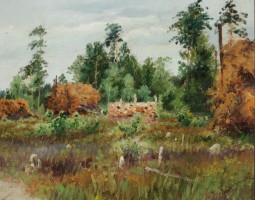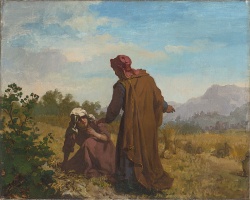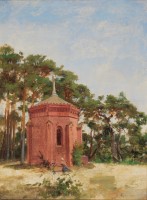

Clearing in the forest
| Author: | Kazimierz Alchimowicz (1840–1916) |
Kazimierz Alchimowicz, a painter, sculptor and teacher, was born on 20 December 1840 in Dziembrów, near Lida (Belarus), and went to school (Gymnasium) in Vilnius. For his participation in the 1863 uprising he was deported to Siberia. In 1869 he was granted amnesty and received permission to live in Warsaw. To learn painting he attended the Warsaw Drawing Class and W. Gerson’s private studio. Between 1873 and 1875 he studied at the Munich Academy of Art and some years afterwards lived in France and participated in the Salon de Paris exhibitions. In 1878 he returned to Warsaw and in 1890, he began to teach drawing at B. Poświkowa’s school of painting and sculpture. He painted pictures on the themes of Lithuanian history and mythology, landscapes, everyday scenes and portraits. He also produced some wall paintings and sculptures of wood and clay. He participated in exhibitions in Warsaw, Cracow, Vilnius, Vienna, Munich and Odessa. For his artistic works he received many awards and medals. In his oeuvre he followed the neo-romantic tradition. He died on 31 December 1916 in Warsaw.
Source: Valiunas Ellex (LAWIN until 2015) art album: THE WORLD OF LANDSCAPES I (2010). Compilers Nijolė Tumėnienė, Dalia Tarandaitė, Jurgita Semenauskienė. Text author Dalia Tarandaitė.

Kazimierz Alchimowicz, a painter, sculptor and teacher, was born on 20 December 1840 in Dziembrów, near Lida (Belarus), and went to school (Gymnasium) in Vilnius. For his participation in the 1863 uprising he was deported to Siberia. In 1869 he was granted amnesty and received permission to live in Warsaw. To learn painting he attended the Warsaw Drawing Class and W. Gerson’s private studio. Between 1873 and 1875 he studied at the Munich Academy of Art and some years afterwards lived in France and participated in the Salon de Paris exhibitions. In 1878 he returned to Warsaw and in 1890, he began to teach drawing at B. Poświkowa’s school of painting and sculpture. He painted pictures on the themes of Lithuanian history and mythology, landscapes, everyday scenes and portraits. He also produced some wall paintings and sculptures of wood and clay. He participated in exhibitions in Warsaw, Cracow, Vilnius, Vienna, Munich and Odessa. For his artistic works he received many awards and medals. In his oeuvre he followed the neo-romantic tradition. He died on 31 December 1916 in Warsaw.
Source: Valiunas Ellex (LAWIN until 2015) art album: THE WORLD OF LANDSCAPES I (2010). Compilers Nijolė Tumėnienė, Dalia Tarandaitė, Jurgita Semenauskienė. Text author Dalia Tarandaitė.








